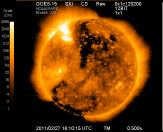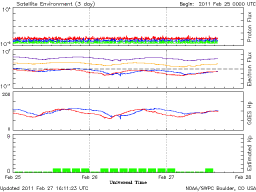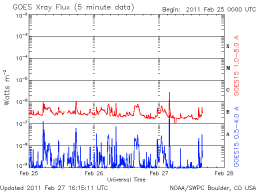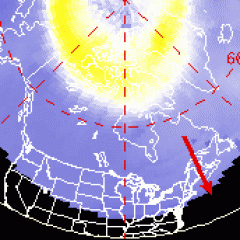Current Space Weather Conditions |
||||||||||||||||||||||||
|
||||||||||||||||||||||||

speed: 317.2 km/sec density: 0.8 protons/cm3 explanation | more data Updated: Today at 1637 UT
6-hr max: B7 1553 UT Feb27 24-hr: C4 0355 UT Feb27 explanation | more data Updated: Today at: 1600 UT
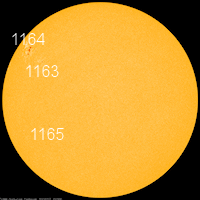
What is the sunspot number? Updated 26 Feb 2011 Spotless Days Current Stretch: 0 days 2011 total: 1 day (2%) 2010 total: 51 days (14%) 2009 total: 260 days (71%) Since 2004: 820 days Typical Solar Min: 486 days Updated 26 Feb 2011 The Radio Sun 10.7 cm flux: 90 sfu explanation | more data Updated 26 Feb 2011
Credit: NOAA/POES
Now: Kp= 1 quiet 24-hr max: Kp= 1 quiet explanation | more data
Btotal: 5.0 nT Bz: 2 nT south explanation | more data Updated: Today at 1637 UT
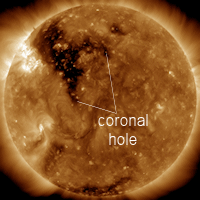
Probabilities for significant disturbances in Earth's magnetic field are given for three activity levels: active, minor storm, severe storm
|
Potentially Hazardous Asteroids (PHAs) are space rocks larger than approximately 100m that can come closer to Earth than 0.05 AU. None of the known PHAs is on a collision course with our planet, although astronomers are finding new ones all the time.
On February 27, 2011 there were 1201
potentially hazardous asteroids.
Recent &
Upcoming Earth-asteroid encounters:
| Asteroid |
Date(UT)
|
Miss Distance
|
Mag.
|
Size
|
| 2011 CL50 |
Feb 19
|
6.2 LD
|
--
|
13 m
|
| 2011 DX4 |
Feb 20
|
8 LD
|
--
|
23 m
|
| 2003 YG118 |
Feb 20
|
67.7 LD
|
--
|
1.8 km
|
| 2011 DQ |
Feb 26
|
9.7 LD
|
--
|
24 m
|
| 2011 DT9 |
Feb 27
|
9 LD
|
--
|
40 m
|
| 2011 DE5 |
Mar 1
|
4.9 LD
|
--
|
22 m
|
| 2011 DW4 |
Mar 3
|
6.9 LD
|
--
|
15 m
|
| 2000 PN9 |
Mar 10
|
45.5 LD
|
--
|
2.6 km
|
| 2002 DB4 |
Apr 15
|
62.5 LD
|
--
|
2.2 km
|
| 2008 UC202 |
Apr 27
|
8.9 LD
|
--
|
10 m
|
| 2009 UK20 |
May 2
|
8.6 LD
|
--
|
23 m
|
| 2008 FU6 |
May 5
|
75.5 LD
|
--
|
1.2 km
|
| 2003 YT1 |
May 5
|
65.3 LD
|
--
|
2.5 km
|
| 2002 JC |
Jun 1
|
57.5 LD
|
--
|
1.6 km
|
| 2009 BD |
Jun 2
|
0.9 LD
|
--
|
9 m
|
| 2002 JB9 |
Jun 11
|
71.5 LD
|
--
|
3.2 km
|
| 2001 VH75 |
Jun 12
|
42.2 LD
|
--
|
1.1 km
|
| 2004 LO2 |
Jun 15
|
9.9 LD
|
--
|
48 m
|
©2010 Spaceweather.com. All rights reserved.
